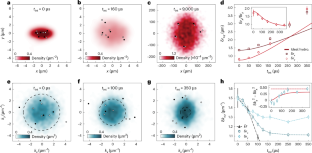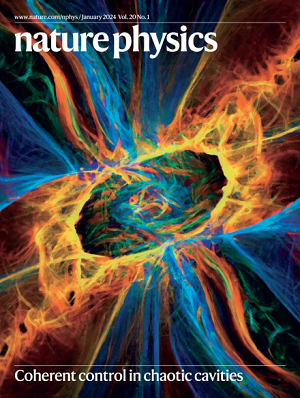Emergent interaction-driven elliptic flow of few fermionic atoms
IF 17.6
1区 物理与天体物理
Q1 PHYSICS, MULTIDISCIPLINARY
引用次数: 0
Abstract
Hydrodynamics is a successful framework for effectively describing the dynamics of complex many-body systems, ranging from subnuclear to cosmological scales. It applies coarse-grained assumptions about the microscopic constituents of a system to define macroscopic fluid cells, which are large compared to the interparticle spacing and mean free path. In high-energy heavy-ion collisions, hydrodynamic behaviour is inferred from the observation of elliptic flow, which is the elliptical deformation of the particle momentum distribution. Here we demonstrate the emergence of elliptic flow in a mesoscopic system with a few strongly interacting ultracold atoms. In our system, a hydrodynamic description is a priori not applicable, as all relevant length scales—the system size, the interparticle spacing and the mean free path—are comparable. The single-particle resolution and the deterministic control over the number of particles and interaction strength in our experiment allow us to explore the boundaries between a microscopic description and a hydrodynamic framework, and we show that elliptic flow appears as an interaction-driven effect. Our results demonstrate the emergence of collective behaviour in a regime where hydrodynamics is not usually applicable. Hydrodynamics can describe the collective behaviour of many-body systems when all the relevant length scales are separable. Now, an experiment with ultracold atoms shows signatures of hydrodynamic behaviour in a regime where length scales are comparable.


少数费米子原子的紧急相互作用驱动椭圆流
流体力学是一个成功的框架,用于有效地描述复杂的多体系统的动力学,范围从亚核到宇宙尺度。它应用关于系统微观成分的粗粒度假设来定义宏观流体细胞,与粒子间距和平均自由程相比,宏观流体细胞很大。在高能重离子碰撞中,流体动力学行为是由观察到的椭圆流推断出来的,椭圆流是粒子动量分布的椭圆变形。在这里,我们证明了椭圆流在具有几个强相互作用的超冷原子的介观体系中的出现。在我们的系统中,水动力描述先验地不适用,因为所有相关的长度尺度-系统大小,粒子间间距和平均自由程-都是可比的。在我们的实验中,单粒子分辨率和对粒子数量和相互作用强度的确定性控制使我们能够探索微观描述和流体动力学框架之间的边界,并且我们表明椭圆流是一种相互作用驱动的效应。我们的结果表明,在流体力学通常不适用的情况下,集体行为的出现。
本文章由计算机程序翻译,如有差异,请以英文原文为准。
求助全文
约1分钟内获得全文
求助全文
来源期刊

Nature Physics
物理-物理:综合
CiteScore
30.40
自引率
2.00%
发文量
349
审稿时长
4-8 weeks
期刊介绍:
Nature Physics is dedicated to publishing top-tier original research in physics with a fair and rigorous review process. It provides high visibility and access to a broad readership, maintaining high standards in copy editing and production, ensuring rapid publication, and maintaining independence from academic societies and other vested interests.
The journal presents two main research paper formats: Letters and Articles. Alongside primary research, Nature Physics serves as a central source for valuable information within the physics community through Review Articles, News & Views, Research Highlights covering crucial developments across the physics literature, Commentaries, Book Reviews, and Correspondence.
 求助内容:
求助内容: 应助结果提醒方式:
应助结果提醒方式:


